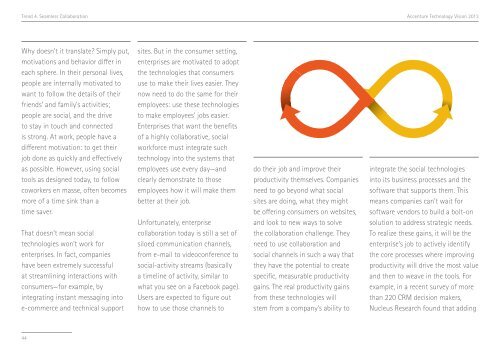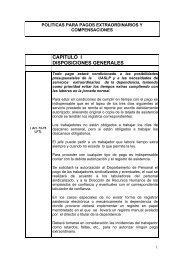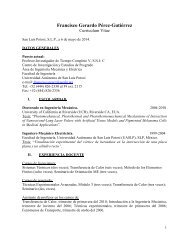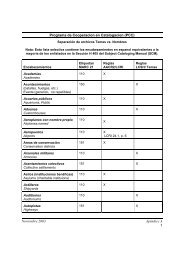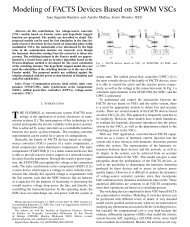Accenture Technology Vision 2013
Accenture Technology Vision 2013
Accenture Technology Vision 2013
Create successful ePaper yourself
Turn your PDF publications into a flip-book with our unique Google optimized e-Paper software.
Trend 4. Seamless Collaboration<br />
<strong>Accenture</strong> <strong>Technology</strong> <strong>Vision</strong> <strong>2013</strong><br />
Why doesn’t it translate Simply put,<br />
motivations and behavior differ in<br />
each sphere. In their personal lives,<br />
people are internally motivated to<br />
want to follow the details of their<br />
friends’ and family’s activities;<br />
people are social, and the drive<br />
to stay in touch and connected<br />
is strong. At work, people have a<br />
different motivation: to get their<br />
job done as quickly and effectively<br />
as possible. However, using social<br />
tools as designed today, to follow<br />
coworkers en masse, often becomes<br />
more of a time sink than a<br />
time saver.<br />
That doesn’t mean social<br />
technologies won’t work for<br />
enterprises. In fact, companies<br />
have been extremely successful<br />
at streamlining interactions with<br />
consumers—for example, by<br />
integrating instant messaging into<br />
e-commerce and technical support<br />
sites. But in the consumer setting,<br />
enterprises are motivated to adopt<br />
the technologies that consumers<br />
use to make their lives easier. They<br />
now need to do the same for their<br />
employees: use these technologies<br />
to make employees’ jobs easier.<br />
Enterprises that want the benefits<br />
of a highly collaborative, social<br />
workforce must integrate such<br />
technology into the systems that<br />
employees use every day—and<br />
clearly demonstrate to those<br />
employees how it will make them<br />
better at their job.<br />
Unfortunately, enterprise<br />
collaboration today is still a set of<br />
siloed communication channels,<br />
from e-mail to videoconference to<br />
social-activity streams (basically<br />
a timeline of activity, similar to<br />
what you see on a Facebook page).<br />
Users are expected to figure out<br />
how to use those channels to<br />
do their job and improve their<br />
productivity themselves. Companies<br />
need to go beyond what social<br />
sites are doing, what they might<br />
be offering consumers on websites,<br />
and look to new ways to solve<br />
the collaboration challenge. They<br />
need to use collaboration and<br />
social channels in such a way that<br />
they have the potential to create<br />
specific, measurable productivity<br />
gains. The real productivity gains<br />
from these technologies will<br />
stem from a company’s ability to<br />
integrate the social technologies<br />
into its business processes and the<br />
software that supports them. This<br />
means companies can’t wait for<br />
software vendors to build a bolt-on<br />
solution to address strategic needs.<br />
To realize these gains, it will be the<br />
enterprise’s job to actively identify<br />
the core processes where improving<br />
productivity will drive the most value<br />
and then to weave in the tools. For<br />
example, in a recent survey of more<br />
than 220 CRM decision makers,<br />
Nucleus Research found that adding<br />
44


